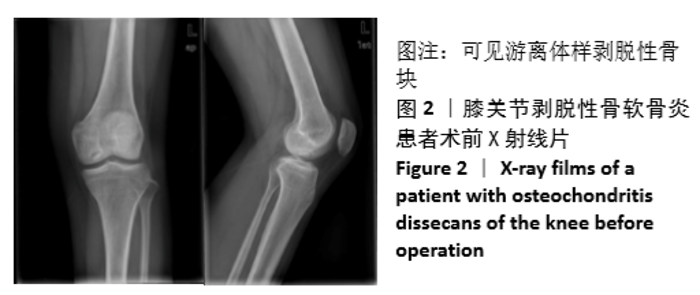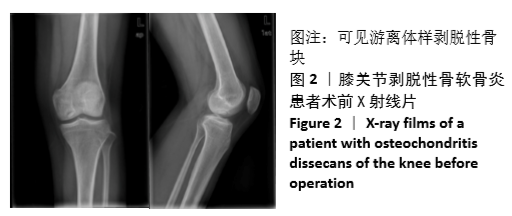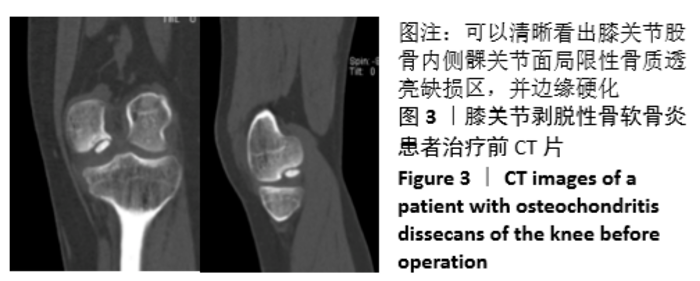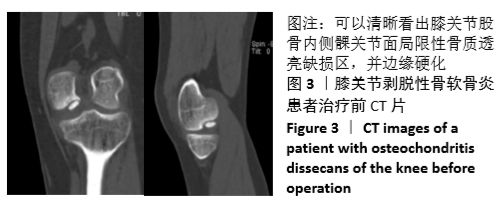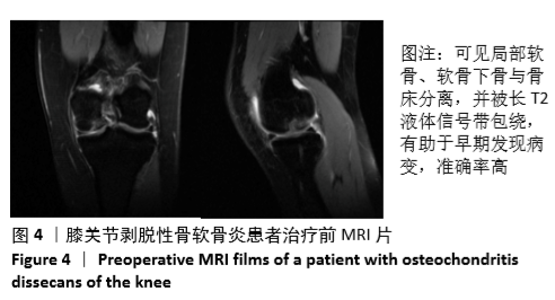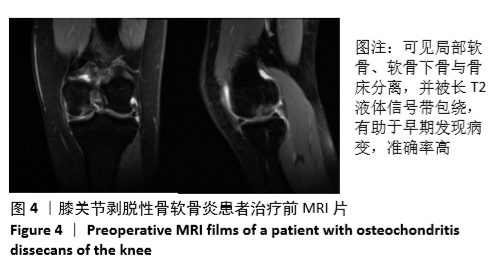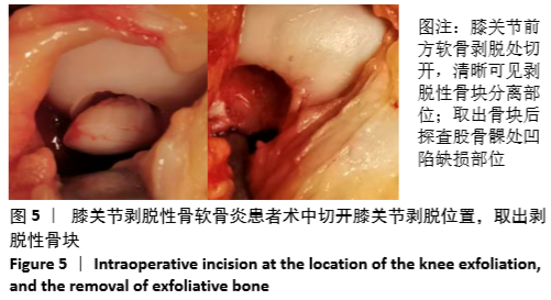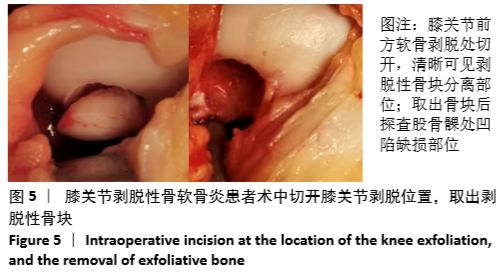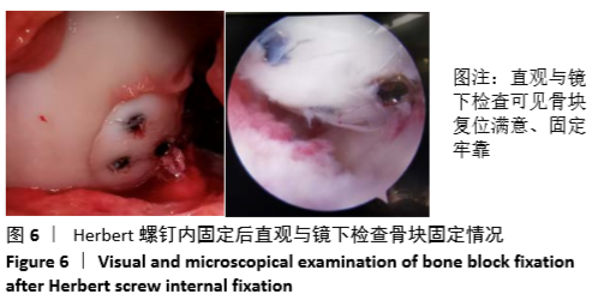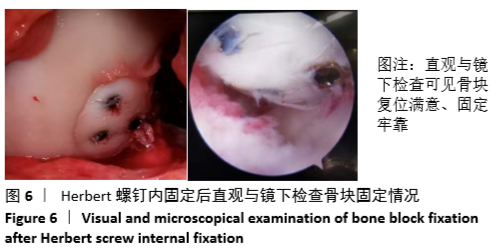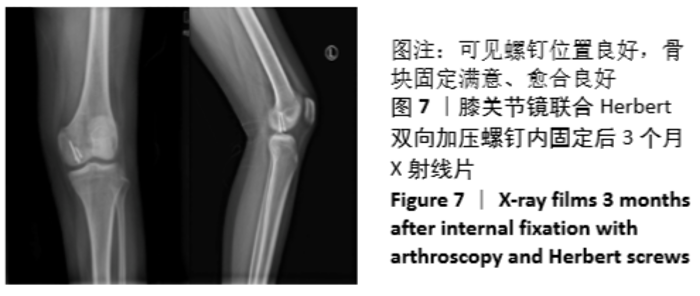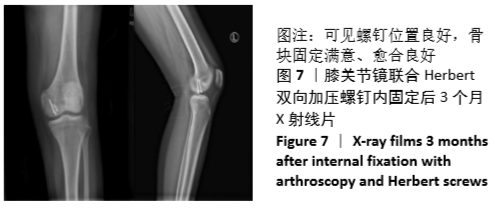Chinese Journal of Tissue Engineering Research ›› 2021, Vol. 25 ›› Issue (3): 397-402.doi: 10.3969/j.issn.2095-4344.2988
Previous Articles Next Articles
Herbert screw internal fixation for treating adult osteochondritis dissecans of the knees
Wang Xiaofei1, Teng Xueren2, Cong Linyan1, Zhou Xu1, Ma Zhenhua2
- 1Dalian Medical University, Dalian 116044, Liaoning Province, China; 2Department of Bone, Joint and Sports Meicine, Qingdao Municipal Hospital, Qingdao 266071, Shandong Province, China
-
Received:2020-02-26Revised:2020-03-05Accepted:2020-04-21Online:2021-01-28Published:2020-11-17 -
Contact:Ma Zhenhua, Master, Associate chief physician, Department of Bone, Joint and Sports Medicine, Qingdao Municipal Hospital, Qingdao 266071, Shandong Province, China -
About author:Wang Xiaofei, Master, Physician, Dalian Medical University, Dalian 116044, Liaoning Province, China
CLC Number:
Cite this article
Wang Xiaofei, Teng Xueren, Cong Linyan, Zhou Xu, Ma Zhenhua. Herbert screw internal fixation for treating adult osteochondritis dissecans of the knees[J]. Chinese Journal of Tissue Engineering Research, 2021, 25(3): 397-402.
share this article
Add to citation manager EndNote|Reference Manager|ProCite|BibTeX|RefWorks
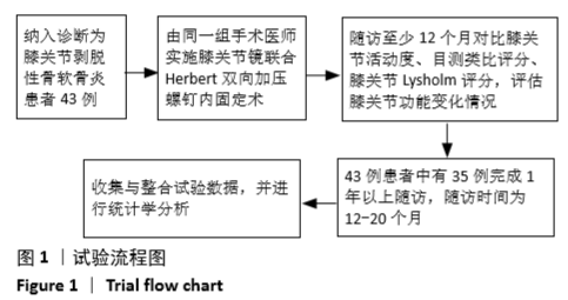
2.1 一般资料 选取2014年6月至2018年9月接受治疗的膝关节剥脱性骨软骨炎患者,43例患者中有35例完成12个月以上随访,并纳入此次研究,其中男21例,女14例;所有患者均为成年人,年龄18-53岁,平均年龄为(29.00±4.62)岁;患者均为单侧膝关节发病,其中左侧肢体16例,右侧肢体19例;所有患者术前均有膝关节疼痛伴有膝关节功能受限,并接受膝关节镜联合Herbert双向加压螺钉内固定治疗,手术时间为45-80 min,平均时间为(60.00±5.57) min;失血量20-50 mL,平均为(30.00± 4.32) mL。术中探查见35例患者中有21例完全剥脱,14例部分剥脱。35例患者随访时间为12-20个月,平均(14.0±2.5)个月。 2.2 试验流程图 见图1。"
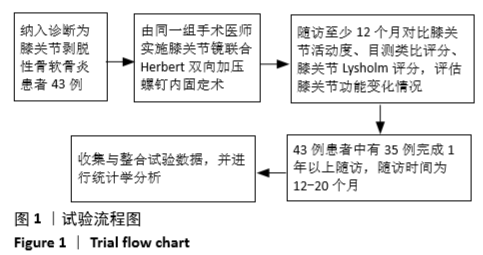
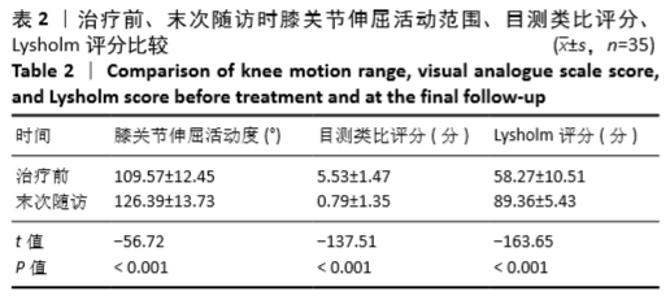
2.3 膝关节活动范围 治疗前膝关节伸屈活动范围为95°-140°,平均(109.57±12.45)°;末次随访时膝关节活动范围为115°-145°,平均(126.39±13.73)°。末次随访时膝关节活动度较术前显著提高,差异有显著性意义,见表2。 2.4 膝关节疼痛变化 治疗前患者膝关节目测类比评分为4-8 分,平均(5.53±1.47)分。治疗后除个别患者因疼痛较敏感仍有轻微疼痛外,大部分患者无明显疼痛,末次随访目测类比评分为0-4分,平均(0.79±1.35)分。治疗后与治疗前目测类比评分相比变化明显,差异有显著性意义,见表2。 2.5 膝关节功能评估 采用膝关节Lysholm评分评价膝关节功能恢复情况,治疗前Lysholm评分评估为45-78分,平均(58.27±10.51)分。治疗后末次随访Lysholm评分为70-95分,平均(89.36±5.43)分。末次随访时Lysholm评分均优于术前,差异有显著性意义,见表2。 "
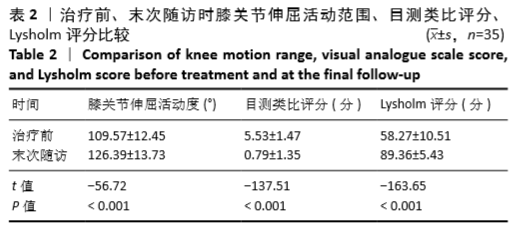
| [1] MESTRINER LA. Osteochondritis dissecans of the knee: diagnosis and treatment. Rev Bras Ortop. 2015;47(5):553-562. [2] GOWD AK, BECK EC, NABOR D, et al. A staged arthroscopic approach to fixation of unstable osteochondritis dissecans in the medial femoral condyle of the knee using nonabsorbable fixation screws. Arthrosc Tech. 2020;9(4):e477-e481. [3] EDMONDS EW, SHEA KG. Osteochondritis dissecans: editorial comment. Clin Orthop Relat Res. 2013;471(4):1105-1106. [4] CRUZ AI JR, SHEA KG, GANLEY TJ. Pediatric knee osteochondritis dissecans lesions. Orthop Clin North Am. 2016;47(4):763-775. [5] ERICKSON BJ, CHALMERS PN, YANKE AB, et al. Surgical management of osteochondritis dissecans of the knee. Curr Rev Musculoskelet Med. 2013;6(2):102-114. [6] KOCHER MS, TUCKER R, GANLEY TJ, et al. Management of osteochondritis dissecans of the knee: current concepts review. Am J Sports Med. 2006;34(7):1181-1191. [7] PASCUAL-GARRIDO C, MCNICKLE AG, COLE BJ. Surgical treatment options for osteochondritis dissecans of the knee. Sports Health. 2009; 1(4):326-334. [8] MATSUURA T, HASHIMOTO Y, KINOSHITA T, et al. Donor site evaluation after osteochondral autograft transplantation for capitellar osteochondritis dissecans. Am J Sports Med. 2019;47(12):2836-2843. [9] MAGNUSSEN RA, CAREY JL, SPINDLER KP. Does operative fixation of an osteochondritis dissecans loose body result in healing and long-term maintenance of knee function? Am J Sports Med. 2009;37(4):754-759. [10] JONES KJ, CASH BM, ARSHI A, et al. Fresh osteochondral allograft transplantation for uncontained, elongated osteochondritis dissecans lesions of the medial femoral condyle. Arthrosc Tech. 2019;8(3): e267-e273. [11] HEVESI M, SANDERS TL, PAREEK A, et al. Osteochondritis dissecans in the knee of skeletally immature patients: rates of persistent pain, osteoarthritis, and arthroplasty at mean 14-years’ follow-up. Cartilage. 2018:1947603518786545. [12] WU IT, CUSTERS RJH, DESAI VS, et al. Internal fixation of unstable osteochondritis dissecans: do open growth plates improve healing rate? Am J Sports Med. 2018;46(10):2394-2401. [13] DONALDSON LD, WOJTYS EM. Extraarticular drilling for stable osteochondritis dissecans in the skeletally immature knee. J Pediatr Orthop. 2008;28(8):831-835. [14] BEXKENS R, OGINK PT, DOORNBERG JN, et al. Donor-site morbidity after osteochondral autologous transplantation for osteochondritis dissecans of the capitellum: a systematic review and meta-analysis. Knee Surg Sports Traumatol Arthrosc. 2017;25(7):2237-2246. [15] PERELLI S, MOLINA ROMOLI AR, COSTA-PAZ M, et al. Internal fixation of osteochondritis dissecans of the knee leads to good long-term outcomes and high degree of healing without differences between fixation devices. J Clin Med. 2019;8(11). pii: E1934. [16] CHADLI L, STELTZLEN C, TOANEN C, et al. Hybrid fixation in adult osteochondritis dissecans of the knee. Orthop Traumatol Surg Res. 2018;104(2):223-225. [17] VERDONK P, DHOLLANDER A, ALMQVIST KF, et al. Treatment of osteochondral lesions in the knee using a cell-free scaffold. Bone Joint J. 2015;97-B(3):318-323. [18] MARTINČIČ D, RADOSAVLJEVIČ D, DROBNIČ M. Ten-year clinical and radiographic outcomes after autologous chondrocyte implantation of femoral condyles. Knee Surg Sports Traumatol Arthrosc. 2014;22(6): 1277-1283. [19] CAREY JL, WALL EJ, GRIMM NL, et al. Novel Arthroscopic Classification of Osteochondritis Dissecans of the Knee: A Multicenter Reliability Study. Am J Sports Med. 2016;44(7):1694-1698. [20] SIEGALL E, FAUST JR, HERZOG MM, et al. Age Predicts Disruption of the Articular Surface of the Femoral Condyles in Knee OCD: Can We Reduce Usage of Arthroscopy and MRI? J Pediatr Orthop. 2018;38(3):176-180. [21] RANDSBORG PH, KJENNVOLD S, RØTTERUD JH. Arthroscopic Fixation of Osteochondritis Dissecans of the Knee Using a Motorized Pick and Headless Compression Screws. Arthrosc Tech. 2019;8(10):e1115-e1120. [22] DENONCOURT PM, PATEL D, DIMAKOPOULOS P. Arthroscopy update #1. Treatment of osteochondrosis dissecans of the knee by arthroscopic curettage, follow-up study. Orthop Rev. 1986;15(10):652-657. [23] ANDERSON AF, PAGNANI MJ. Osteochondritis dissecans of the femoral condyles. Long-term results of excision of the fragment. Am J Sports Med. 1997;25(6):830-834. [24] MURRAY JR, CHITNAVIS J, DIXON P, et al. Osteochondritis dissecans of the knee; long-term clinical outcome following arthroscopic debridement. Knee. 2007;14(2):94-98. [25] GUHL JF. Arthroscopic treatment of osteochondritis dissecans. Clin Orthop Relat Res. 1982;(167):65-74. [26] RANDSBORG PH. Editorial commentary: unstable osteochondritis dissecans in the mature knee: internal fixation works, but we need more data. Arthroscopy. 2019;35(8):2523-2524. [27] WINTHROP Z, PINKOWSKY G, HENNRIKUS W. Surgical treatment for osteochondritis dessicans of the knee. Curr Rev Musculoskelet Med. 2015;8(4):467-475. [28] PROUBASTA IR, ITARTE JP, LAMAS CG, et al. Midshaft clavicular non-unions treated with the Herbert cannulated bone screw. J Orthop Surg (Hong Kong). 2004;12(1):71-75. [29] ISHIKAWA M, NAKAMAE A, NAKASA T, et al. Limitation of in-situ arthroscopic fixation for stable juvenile osteochondritis dissecans in the knee. J Pediatr Orthop B. 2018;27(6):516-521. [30] STEADMAN JR, BRIGGS KK, RODRIGO JJ, et al. Outcomes of microfracture for traumatic chondral defects of the knee: average 11-year follow-up. Arthroscopy. 2003;19(5):477-484. [31] HANGODY L, FÜLES P. Autologous osteochondral mosaicplasty for the treatment of full-thickness defects of weight-bearing joints: ten years of experimental and clinical experience. J Bone Joint Surg Am. 2003;85-A Suppl 2:25-32. [32] MINIACI A, TYTHERLEIGH-STRONG G. Fixation of unstable osteochondritis dissecans lesions of the knee using arthroscopic autogenous osteochondral grafting (mosaicplasty). Arthroscopy. 2007; 23(8):845-851. |
| [1] | Xu Feng, Kang Hui, Wei Tanjun, Xi Jintao. Biomechanical analysis of different fixation methods of pedicle screws for thoracolumbar fracture [J]. Chinese Journal of Tissue Engineering Research, 2021, 25(9): 1313-1317. |
| [2] | Jiang Yong, Luo Yi, Ding Yongli, Zhou Yong, Min Li, Tang Fan, Zhang Wenli, Duan Hong, Tu Chongqi. Von Mises stress on the influence of pelvic stability by precise sacral resection and clinical validation [J]. Chinese Journal of Tissue Engineering Research, 2021, 25(9): 1318-1323. |
| [3] | Zhang Tongtong, Wang Zhonghua, Wen Jie, Song Yuxin, Liu Lin. Application of three-dimensional printing model in surgical resection and reconstruction of cervical tumor [J]. Chinese Journal of Tissue Engineering Research, 2021, 25(9): 1335-1339. |
| [4] | Zhang Yu, Tian Shaoqi, Zeng Guobo, Hu Chuan. Risk factors for myocardial infarction following primary total joint arthroplasty [J]. Chinese Journal of Tissue Engineering Research, 2021, 25(9): 1340-1345. |
| [5] | Li Dadi, Zhu Liang, Zheng Li, Zhao Fengchao. Correlation of total knee arthroplasty efficacy with satisfaction and personality characteristics [J]. Chinese Journal of Tissue Engineering Research, 2021, 25(9): 1346-1350. |
| [6] | Wei Wei, Li Jian, Huang Linhai, Lan Mindong, Lu Xianwei, Huang Shaodong. Factors affecting fall fear in the first movement of elderly patients after total knee or hip arthroplasty [J]. Chinese Journal of Tissue Engineering Research, 2021, 25(9): 1351-1355. |
| [7] | Wang Jinjun, Deng Zengfa, Liu Kang, He Zhiyong, Yu Xinping, Liang Jianji, Li Chen, Guo Zhouyang. Hemostatic effect and safety of intravenous drip of tranexamic acid combined with topical application of cocktail containing tranexamic acid in total knee arthroplasty [J]. Chinese Journal of Tissue Engineering Research, 2021, 25(9): 1356-1361. |
| [8] | Xiao Guoqing, Liu Xuanze, Yan Yuhao, Zhong Xihong. Influencing factors of knee flexion limitation after total knee arthroplasty with posterior stabilized prostheses [J]. Chinese Journal of Tissue Engineering Research, 2021, 25(9): 1362-1367. |
| [9] | Huang Zexiao, Yang Mei, Lin Shiwei, He Heyu. Correlation between the level of serum n-3 polyunsaturated fatty acids and quadriceps weakness in the early stage after total knee arthroplasty [J]. Chinese Journal of Tissue Engineering Research, 2021, 25(9): 1375-1380. |
| [10] | Zhang Chong, Liu Zhiang, Yao Shuaihui, Gao Junsheng, Jiang Yan, Zhang Lu. Safety and effectiveness of topical application of tranexamic acid to reduce drainage of elderly femoral neck fractures after total hip arthroplasty [J]. Chinese Journal of Tissue Engineering Research, 2021, 25(9): 1381-1386. |
| [11] | Wang Haiying, Lü Bing, Li Hui, Wang Shunyi. Posterior lumbar interbody fusion for degenerative lumbar spondylolisthesis: prediction of functional prognosis of patients based on spinopelvic parameters [J]. Chinese Journal of Tissue Engineering Research, 2021, 25(9): 1393-1397. |
| [12] | Lü Zhen, Bai Jinzhu. A prospective study on the application of staged lumbar motion chain rehabilitation based on McKenzie’s technique after lumbar percutaneous transforaminal endoscopic discectomy [J]. Chinese Journal of Tissue Engineering Research, 2021, 25(9): 1398-1403. |
| [13] | Chen Xinmin, Li Wenbiao, Xiong Kaikai, Xiong Xiaoyan, Zheng Liqin, Li Musheng, Zheng Yongze, Lin Ziling. Type A3.3 femoral intertrochanteric fracture with augmented proximal femoral nail anti-rotation in the elderly: finite element analysis of the optimal amount of bone cement [J]. Chinese Journal of Tissue Engineering Research, 2021, 25(9): 1404-1409. |
| [14] | Du Xiupeng, Yang Zhaohui. Effect of degree of initial deformity of impacted femoral neck fractures under 65 years of age on femoral neck shortening [J]. Chinese Journal of Tissue Engineering Research, 2021, 25(9): 1410-1416. |
| [15] | Zhang Shangpu, Ju Xiaodong, Song Hengyi, Dong Zhi, Wang Chen, Sun Guodong. Arthroscopic suture bridge technique with suture anchor in the treatment of acromioclavicular dislocation [J]. Chinese Journal of Tissue Engineering Research, 2021, 25(9): 1417-1422. |
| Viewed | ||||||
|
Full text |
|
|||||
|
Abstract |
|
|||||
